Are you looking to build a stronger and more defined upper body? Look no further than these barbell back exercises.
These exercises not only target your back muscles but also engage your arms, shoulders, and core.
With a variety of exercises to choose from, you can mix and match to create a workout that suits your fitness goals.
In this article, we’ll be exploring 8 of the best barbell back exercises that will help you achieve the upper body strength and definition you desire.
Moreover, whether you’re a seasoned weightlifter or a beginner looking to up your fitness game, these exercises are sure to challenge and push you to the next level.
Here is a list of the 8 best barbell back exercises for your back:
Here is a list of
- Barbell row
- Deadlift
- Good morning
- Barbell shrug
- T bar row
- Reverse grip barbell row
- Chest row
- Rack pull
So grab a suitable barbell, get ready to sweat, and let’s get started!
Specifically, there are 3 barbell exercises for lower back:
Deadlift
Rack pull
Good morning
How to Do a Barbell Row
The barbell row is a classic back exercise that targets your lats, traps, and rhomboid. Have a look at their images respectively
Here are 4 steps for performing the barbell row correctly
. Credits:built with science
- Stand with your feet shoulder-width apart and your knees slightly bent. Hold the barbell with an overhand grip, palms facing down.
2. Bend forward at the hips, keeping your back straight and your head up. Your torso should be almost parallel to the ground.
This is extremely important, you should completely make sure that your back is not bent.
3. Pull the barbell up towards your chest, keeping your elbows close to your body. Squeeze your shoulder blades together at the top of the movement.
4. Lower the barbell back down to the starting position, keeping your back straight(very important) and your head up.
How to Do a Deadlift (my favourite)
In my opinion, this tops the list of the best barbell back exercises and tops the list of barbell exercises for lower back
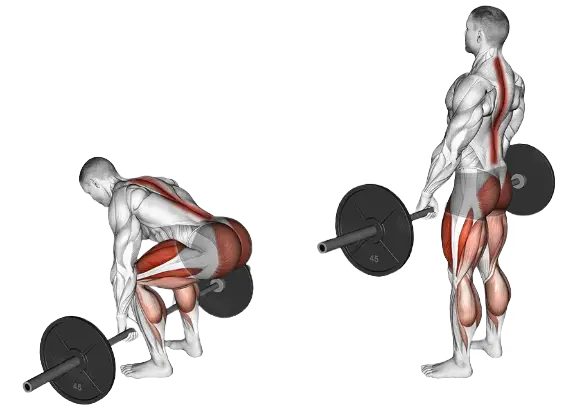
Here are 6 steps for performing the Deadlift correctly.
The deadlift is a compound exercise that targets your entire back, as well as your glutes, hamstrings, and core. To perform this exercise, follow these steps:
1. Stand with your feet shoulder-width apart and your toes pointed slightly outwards.
Place the barbell on the ground in front of you.
2. Bend down and grasp the barbell with an overhand grip, palms facing down. Your hands should be shoulder-width apart.
3. Furthermore, now you have your knees bent and are holding the barbell, now slightly bend your knees more until your shin touches the bar.
4. Now your hip is in a perfect position (don’t move it now), now make sure your back is straight, do it by looking in front and getting your chest out (you might ask someone to verify if your back is straight).
Pro tip:
Clean the barbell to make sure the deadlift is smooth and effective. Here’s how you can clean your barbell.
5. Lift the barbell off the ground, keeping your above-said position maintained, you should be standing upright at the top of the movement(don’t hunch your shoulders just stand with the barbell whilst maintaining your position).
6. Lower the barbell back down to the ground, keeping your back straight and your head up.
Related: How to do a bench press
How to Do a Good Morning
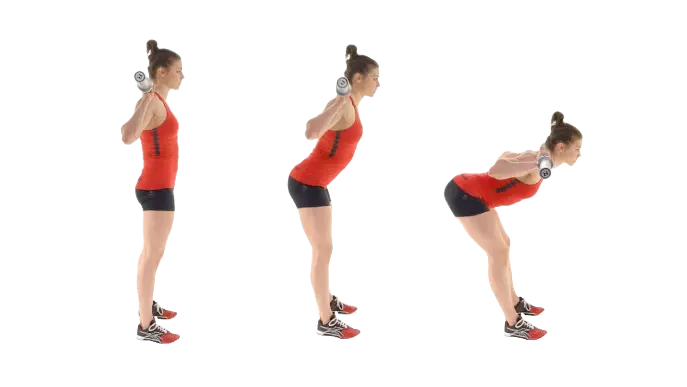
Here are 3 steps of performing the good morning exercise correctly. It is also included in the list of the top barbell exercises for lower back.
Good morning is a back exercise that targets your lower back, glutes, and hamstrings. To perform this exercise, follow these steps:
1. Stand with your feet shoulder-width apart and your knees slightly bent. Hold the barbell on your shoulders, behind your head.
2. Bend forward at the hips, keeping your back straight and your head up. Your torso should be almost parallel to the ground.
3. Lift your torso back up to the starting position, using your lower back, glutes, and hamstrings(the mind-muscle connection is very important)
Related: the proper way to train glutes
How to Do a Barbell Shrug
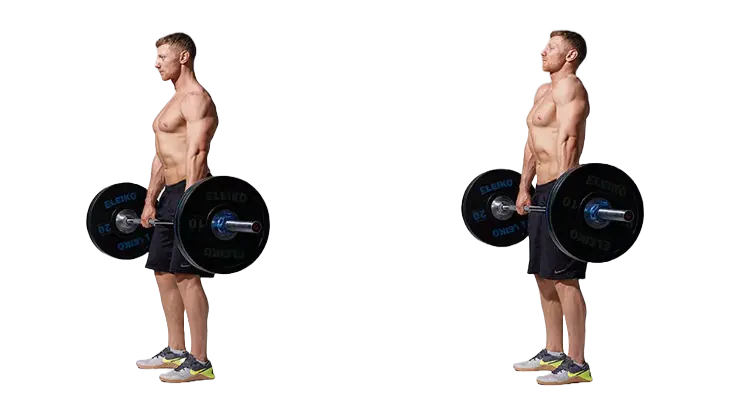
Here are 3 steps of performing the Barbell shrug correctly.
The barbell shrug is an exercise that targets your traps. To perform this exercise, follow these steps:
1. Stand with your feet shoulder-width apart and your knees slightly bent. Hold the barbell with an overhand grip, palms facing down.
2. Lift your shoulders up towards your ears, keeping your arms straight.
3. Lower your shoulders back down to the starting position.
How to do a T-bar row(my second favourite)
This falls in second place for its effectiveness and hypertrophy in the list of the best barbell back exercises
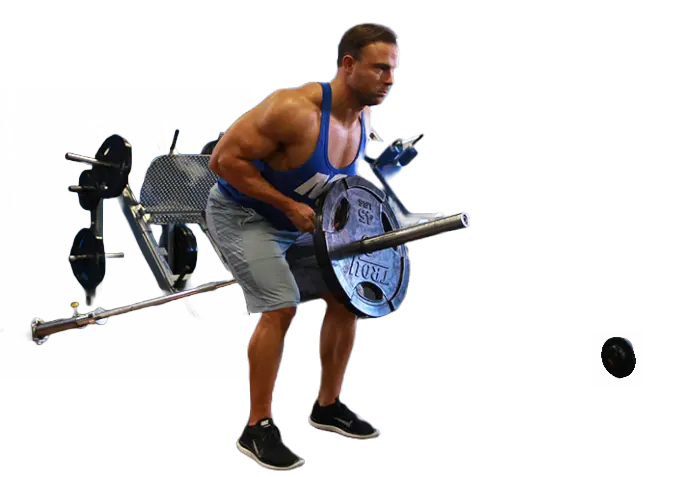
Here are 5 steps for performing the T-bar row correctly.
1. Place one end of a barbell into a landmine attachment or secure it in a corner with a barbell attachment or you can also put a weight plate on the opposite end from where you will pick the barbell up to keep it stable.
Load the other end of the barbell with weight plates according to your desired resistance level.
2. Stand facing the weighted end of the barbell. Moreover, position your feet a bit more than shoulder-width apart almost like an athletic stance, with a slight bend in your knees.
Lean forward from the hips, keeping your back straight and parallel to the floor(very important). Grasp the handles(you can use cable row handles) or the neutral grip close to the weight plates, with palms facing each other.
Here is an image of the handles you will require
3. Brace your core and retract your shoulder blades, maintaining a stable torso throughout the exercise. This is your starting position.
4. Exhale as you pull the barbell towards your torso by driving your elbows back and keeping them close to your body. Remember your back and torso stay parallel to the ground.
Focus on squeezing your back muscles, particularly your lats, as you pull the weight up. Maintain control and avoid using momentum or excessive swinging.
5 At the top of the movement, when the barbell reaches your torso, squeeze your back muscles for a brief pause.
Feel the contraction in your upper back. Let the muscle fibre break!
Pro tips:
- Keep your back straight and avoid rounding or arching during the exercise.
- Avoid using excessive momentum or jerking motions; prioritize a controlled and smooth movement.
- Focus on feeling the contraction in your back muscles throughout the exercise.
- Start with lighter weights and gradually increase the load as you become more comfortable and proficient with the exercise.
How to do a reverse grip barbell row
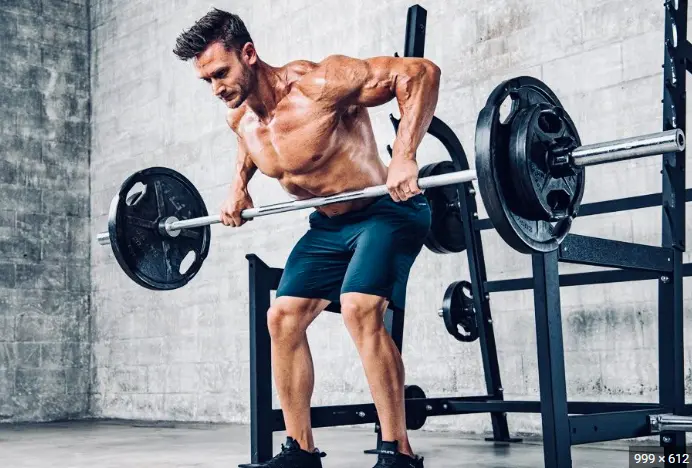
This tops the list as the most skill-requiring exercise to perform out of all the barbell back exercises
Here are 6 steps to perform the reverse grip barbell row
1.Load an appropriate weight onto the barbell and place it on the floor in front of you.
Hold the barbell with an overhand grip (palms facing down), hands slightly narrower than shoulder-width apart.
2. Stand with your feet shoulder-width apart and slightly bend your knees. Hinge forward from the hips, maintaining a straight back parallel to the floor. Keep your upper body at around a 45-degree angle.
3. Rotate your hands to an underhand grip (palms facing up) while keeping a slightly narrower grip than shoulder-width. This is your starting position.
4. Brace your core, retract your shoulder blades, and maintain a straight back.
Exhale as you pull the barbell up towards your lower chest, driving your elbows back and keeping them close to your body.
5. Pause at the top of the movement, when the barbell reaches your lower chest, and squeeze your back muscles. Emphasize the contraction in your upper back and biceps.
6. Inhale as you slowly and in a controlled manner, lower the barbell back down, fully extending your arms. Keep tension in your back muscles throughout the descent.
Pro tips:
- Keep your back straight and avoid rounding or arching during the exercise.
- Maintain a stable torso and avoid using momentum or swinging to lift the weight.
How to do the chest row
 credits:mens health
credits:mens health
Here are 6 steps to performing the chest row
1.Adjust the bench on a 20 kg weight plate to keep the bench off the ground to a comfortable height where your chest can rest firmly on the pad.
Ensure your feet are planted on the ground with a slight bend in your knees.
2. Lie face down on the bench, making sure your chest is securely against the pad.
Reach forward and grasp the barbell with a grip slightly wider than shoulder-width.
3. Stabilize your spine by activating your core muscles.
Maintain a neutral posture throughout the exercise, keeping your neck aligned with your spine and looking down towards the floor.
4. Exhale and retract your shoulder blades, pulling the barbell towards your chest.
Focus on squeezing your back muscles, particularly your lats, as you perform the pulling motion.
5. Once the barbell reaches your chest, hold the position for a moment, squeezing your back muscles. Feel the engagement in your upper back.
Inhale and slowly extend your arms, allowing the barbell to return to the starting position in a controlled manner.
Maintain tension in your back muscles throughout the movement.
Pro tips:
- Keep your chest firmly against the pad throughout the exercise to maintain stability and effectively target the back muscles.
- Avoid arching your lower back or lifting your hips off the bench.
- Make sure to retract your shoulder blades and keep your elbows pointing backwards during the pulling motion.
- Also, make sure your equipment is clean to prevent any health risk
How to do the rack pull
 credits:coach web
credits:coach web
Rack Pull is another great addition to your list of barbell exercises for lower back
Here are 4 steps to perform the rack pull
1.Adjust the safety bars of a power rack or squat rack to the desired height, typically around knee level.
Also make sure the barbell is positioned on the safety bars, just above your knees.
2. Stand with your feet shoulder-width apart, toes pointing slightly outward. Moreover, position yourself in front of the barbell, aligning it with the middle of your feet.
Now bend your knees and hinge forward at the hips, maintaining a slight arch in your lower back. Grasp the barbell with an overhand grip.
3. Brace your core muscles to stabilize your spine and maintain a neutral posture throughout the exercise.
Make sure you keep your shoulder blades retracted and your chest lifted.
Now Push through your heels, extend your knees, and drive your hips forward to lift the barbell off the safety bars.
As you lift, maintain a straight back, ensuring your hips and shoulders rise together.
4. Once you reach a fully upright position with your hips and knees extended, pause momentarily, and squeeze your glutes.
You have to maintain a strong and stable posture.
Hinge at the hips and slowly lower the barbell back down, keeping your back straight and engaging your core. Lower the barbell until it rests on the safety bars.
Pro tips:
- Keep the barbell close to your body throughout the lift to maintain stability and prevent excessive strain on your lower back.
- Focus on controlled movements and avoid using momentum to lift the weight.
3 Common Mistakes to Avoid
When performing barbell back exercises, it’s important to avoid common mistakes that can lead to injury or ineffective workouts.
The 3 common mistakes to avoid include:
– Rounding your back: This can put a strain on your lower back and lead to injury. Keep your back straight and your head up.
– Using too much weight: This can lead to improper form and make the exercise less effective. Start with a weight that allows you to perform the exercise with proper form.
– Jerking the weight: This can put a strain on your joints and lead to injury. Lift the weight in a controlled manner.
Related: How to do the leg curl
Benefits of Barbell Back Exercises
Barbell back exercises are highly beneficial for building upper body strength and definition.
These exercises primarily target your back muscles, but they also engage your arms, shoulders, and core. This makes them a great choice for anyone looking to build a well-rounded upper body.
One of the key benefits of barbell back exercises is that they allow you to lift heavy weights.
This is particularly important for building strength, as heavy lifting is key to making progress.
Another benefit of barbell back exercises is that they are highly functional. This means that they mimic movements that you would use in everyday life, such as lifting heavy objects or pushing and pulling.
By incorporating these exercises into your workout routine, you can build strength that will translate to real-life scenarios.
Finally, barbell back exercises are highly customizable. There are a variety of exercises to choose from, each of which targets different muscles and provides a unique challenge.
This means that you can mix and match exercises to create a workout that suits your fitness goals and preferences.
FAQS
How can I build a bigger back using barbell back exercises?
To increase the size of your back using a barbell, you can incorporate specific exercises into your routine.
Barbell rows, deadlifts, and pull-ups are excellent choices as they engage major back muscles like the latissimus dorsi, rhomboids, and erector spinae.
Start with a challenging weight that allows proper form and gradually increase the load as you progress.
Consistency and correct technique are crucial for achieving a bigger back with a barbell.
What are some ways to train my back at home using a barbell?
If you want to train your back at home with a barbell, there are a few options available. Exercises like bent-over rows, barbell deadlifts, and barbell shrugs can effectively target your back muscles.
How can I develop a significantly thicker back?
Building a thick back requires targeted exercises that engage the major muscle groups. Incorporating compound movements such as deadlifts, bent-over rows, and pull-ups is crucial.
Additionally, exercises like lat pulldowns, cable rows, and reverse flyes can isolate specific muscles in the back.
Gradually increasing weights or resistance through progressive overload stimulates muscle growth and thickness.
Adequate protein intake, a balanced diet, and allowing sufficient recovery time are also important factors in achieving a super thick back.
Which muscles contribute to a larger back?
A bigger back is the result of various muscle groups working together. The primary muscles involved are the latissimus dorsi (lats), which give the back a V-shaped appearance.
Other muscles that contribute to back size include the rhomboids, trapezius and posterior deltoids.
Related: Best barbell bicep exercises
Is it challenging to grow back muscles?
Back muscles are considered a large muscle group and respond well to progressive overload training with proper form
A well-rounded training program that includes a variety of exercises targeting different areas of the back, along with sufficient rest and recovery, is essential.
Consistency, patience, and a balanced approach to training and nutrition are key to successfully growing back muscles.
Wrap it up
What excuses are you left with now????
Back muscles are considered a large muscle group and respond well to progressive overload training with proper form
That you don’t have a rowing machine? Well, now you know that you can target every single muscle yes every single muscle using just barbell and proper technique as given above.
Also back plays a huge part in making your overall body look like a dreamboat.
So don’t wait and get started with these barbell back exercises NOW!
About me

Hi, I am Abdullah a guy whose passion for fitness led to his bachelor’s degree in exercise science, for me what started as a personal fascination soon transformed into a professional career. Over the last six years, I have had the privilege of guiding and supporting numerous individuals on their own fitness journeys. Whether they were beginners taking their first steps into the gym or seasoned athletes aiming to break their personal records, I have been there every step of the way, providing personalized training programs tailored to their unique needs and goals.

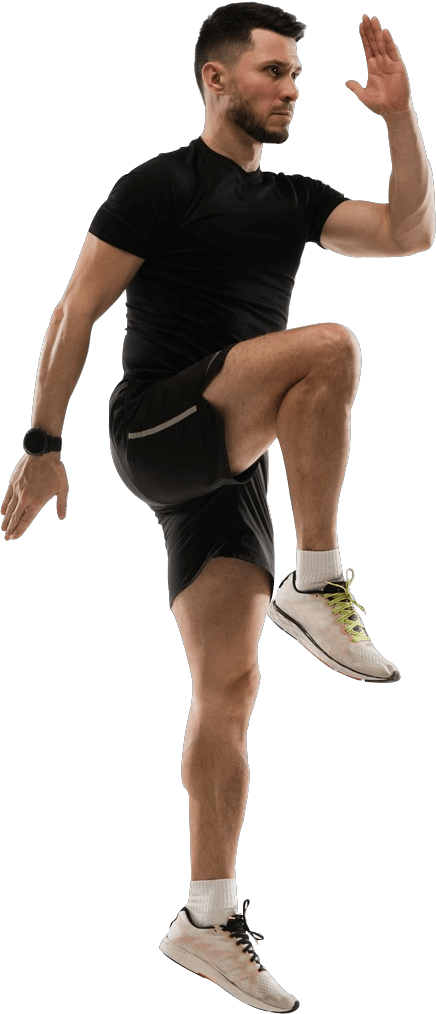
Pingback: 8 best barbells critically tried and tested by us - YourGymPartner